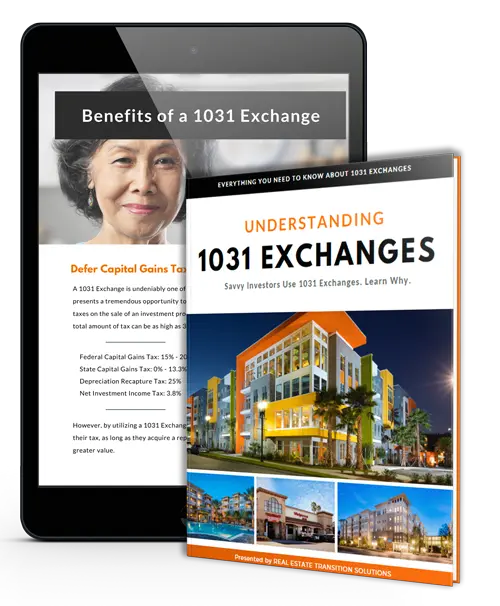
1031 Exchange Basics
- By Austin Bowlin, CPA
What is a 1031 Exchange?
A 1031 Exchange is a transaction approved by the IRS allowing real estate investors to defer the tax liability on the sale of investment property. The transaction gets its name from Section 1031 of the U.S. Internal Revenue Code, which allows investors to defer capital gains tax on the proceeds of a recently sold investment property by reinvesting the proceeds into another like-kind property of equal or greater value.
Sometimes referred to as “like-kind exchanges”, 1031 Exchanges have been in existence for nearly 100 years and are used by thousands of real estate investors every year. The deferral of taxes resulting from the sale of investment property allows for investors to reposition investment real estate to help meet their objectives while preserving all of their equity so it continues to work for them.
Understanding 1031 Exchange Basics
Investors should have a well-rounded understanding of 1031 Exchange basics before selling their investment property. IRS rules must be strictly followed in order to complete a valid 1031 Exchange, including eligibility requirements, qualified properties, and exchange timelines.
To be eligible for a 1031 exchange, three criteria must be met:
- The investment property purchased (replacement property) must be of equal or greater value than the investment property sold (relinquished property).
- Investors must use all proceeds resulting from the sale of the relinquished property to purchase the replacement property.
- Both the relinquished property and replacement property must qualify as “like-kind” property.
IRS rules also require certain deadlines to be met to complete an exchange, including 45 days to identify potential replacement properties and 180 days to acquire the replacement property, thus completing the exchange.
1031 Exchange Benefits
There are many benefits of 1031 Exchanges. The primary benefit of a 1031 Exchange is the deferral of taxes resulting from the sale of investment property. 1031 Exchanges can only be used for the sale of investment real estate. No other types of investments have this very generous section of the tax code available to them.
Tax deferral is not the only benefit of 1031 Exchanges. There are many other benefits of 1031 Exchanges to consider, including:
- Deferral of taxes, including federal capital gains tax, state capital gains tax, net investment income tax, and depreciation recapture tax
- Maximize cash flow potential and investment dollars
- Eliminate inheritance and estate tax for beneficiaries
- Reduce risk through diversification
- Access to properties that do not require active management
- Access to different markets and property types
Types of 1031 Exchanges
Although 1031 Exchanges have been in the tax code since 1921, the first 63 years of exchanges only permitted what is referred to as a “Simultaneous Exchange” in which property was swapped one-for-one for other property. This structure required two owners to each want the other’s property, agree to trade, and then transfer ownership directly to the other.
Following a major Federal tax court case referred to as the “Starker Case” in the 1980s, “Delayed Exchanges” were permitted by the IRS. Delayed Exchanges are significantly more flexible than Simultaneous Exchanges because the exchanger can sell their investment property to any buyer, then perform an Exchange into like-kind replacement property with the resulting sales proceeds, provided they adhere to a number of specific rules. The most common type of exchange format today is a Delayed Exchange, where investors have 180 days to purchase replacement property following the sale of their relinquished property.
In a Reverse Exchange, the replacement property is acquired first. This strategy helps buyers purchase a new investment property as soon as it becomes available instead of being forced to sell their property first. Alternative structures include Improvement Exchanges, Simultaneous Exchanges and Partial Exchanges.
Download FREE Guide
1031 Exchange Basics
Learn how Exchanges work, the benefits vs. risks, IRS rules & timing, property types, and exchange options available

What Are the Rules for a 1031 Exchange?
While 1031 Exchanges are flexible in the number of strategies that can be implemented, the rules put forward by the IRS are not flexible. Failure to adhere to IRS rules can result in either a failed Exchange, in which the entire tax liability is due or a Partial Exchange, in which a portion of the tax liability is due. The IRS’s motivation for allowing 1031 Exchanges is to facilitate continuous investment in real estate that is held for business or investment purposes.
Exchange rules focus on two primary elements. First, there is not an infinite timeline to perform a 1031 Exchange. Second, no “economic benefit” is received by an exchanger without having paid tax. The IRS defines “economic benefit” as either receiving cash compensations (i.e. sales proceeds) or a reduction in a liability (i.e. mortgage and debt payoff) without matching the liability with a corresponding liability on the replacement property or contributing additional equity to the replacement property.
Investors considering an exchange should become familiar with the details of 1031 Exchange rules. Here is a summary of the seven primary rules:
- The exchange must be set up before a sale occurs
- The exchange must be for like-kind property
- The exchange property must be of equal or greater value
- The property owner must pay capital gains and/or depreciation recapture tax on “boot”
- The taxpayer that sold and acquired the exchange property must be the same
- The property owner has 45 days following the sale to identify replacement properties
- The property owner has 180 days following the sale to complete the exchange.
Types of 1031 Exchange Properties
There are many different types of 1031 Exchange properties for an investment property owner to consider. The IRS requires 1031 Exchange properties be “like-kind”, meaning investment property for investment property and includes all property types such as residential, industrial, commercial, etc. Given that all property types can be considered for a 1031 Exchange, the following property categories can be used to compare attributes and characteristics of 1031 Exchange properties:

Delaware Statutory Trust Properties
Delaware Statutory Trusts (commonly referred to as “DSTs”) are a form of ownership that allow an exchanger to acquire fractional ownership of large “institutional quality” properties. There are many similarities with the Real Estate Investment Trust (“REIT”) structure, with one key difference being that property owners can perform a 1031 exchange into DST properties but cannot directly into a REIT.
The property held within the Delaware Statutory Trust is acquired and managed by an institutional real estate firm, referred to as the “DST Sponsor”. The sponsor first acquires the property, then makes it available to exchangers to invest in and will make all operating decisions for the property while providing income potential for the investors. Once sold, the investors receive their pro-rata portion of the sales proceeds (including any appreciation, if applicable) and can then perform another 1031 Exchange into new like-kind real estate, pay tax, or a combination of the two. There are many property types represented within DSTs, however each DST will only own one property type, allowing exchangers to create a combination that matches their individual objectives.
DST properties have become an increasingly popular option throughout the last 10 years due to a number of factors.
First, given the fact the DST sponsor manages the property, there is no management responsibility for the investors. Second, fractional ownership and relatively low investment minimums (typically $100,000 of equity) allow for exchangers to invest in multiple DST properties – in effective creating their own custom diversified portfolio among different property types, lease durations, geographic locations, anticipated hold terms, etc. Third, Delaware Statutory Trusts typically provide competitive income potential. Fourth, there are significant estate planning benefits unique to the Delaware Statutory Trust structure.
None of this is to say that DST properties are without risk; they are still very much direct ownership of investment real estate. However, there are features associated with DST properties that contribute to their increased popularity in recent years.
Tenant-in-Common (TIC) Properties
Tenant-in-Common (commonly referred to as “TIC”) property is another form of ownership that allows for an exchanger to acquire fractional ownership of larger properties.
Tenant-in-Common ownership was blessed by the IRS as qualifying for 1031 exchanges in 2002, two years before DST property was approved for exchanges. Initially, TIC property was a very popular exchange option, however there is some inherent instability in the ownership structure that has led to the DSTs becoming the preferred structure for diverse unaffiliated ownership groups.
It is worth noting that the Tenant-in-Common structure does provide more flexibility as it relates to what is allowable with the property compared to that of the DST structure. For instance, the DST structure does not allow for any major structural changes to the property other than those necessary for maintenance purposes.
The TIC structure has no restrictions as to what can be done with the property; significant renovations, ground up construction, permitting and entitlement work are all allowed within a TIC. Tenant-in-Common investments tend to vary widely from one another. Often the number of investors is smaller and thus the minimum investment amounts are higher – typically around $1 million.
Net Lease Properties
While not a form of ownership, Net Lease property is unique due to the lease structure and the fact that many owners of actively managed short-term lease properties such as rental homes, apartment buildings, mobile homes, hospitality and self-storage consider Net Lease properties as a way to continue to own investment real estate with potentially less management effort.
In effect, Net Lease means that the tenant is responsible for paying all or a portion of the property’s operating expenses and potentially even maintaining the property such that it can be returned to the owner upon the end of the lease term in its original condition. Lease durations vary and typically range between 3 years for commercial office or industrial property all the way out to 50 years or more for some retail and corporate offices.
Net Lease property can be owned outright by an investor (fee simple), through a Delaware Statutory Trust, or Tenant in Common structure. With all Net Lease properties, it is very important to consider the tenant’s ability to pay their remaining lease obligation as this is a key input of the property’s value.
Fee Simple Properties
Fee simple properties includes any property directly owned and often managed by the exchanger. This is this the most common form of ownership and includes various ownership structures such as LLCs, Family Trusts, S.Corps, Sole Proprietorships and Partnerships.
Fee Simple ownership is utilized for all property types and has no restrictions from an ownership structure standpoint as to what can be done with the property from an enhancement, development, financing or sale standpoint. The only restrictions would be those layered on the property through an operating agreement.
The major benefit of Fee Simple ownership is the flexibility associated with it, however with flexibility comes management effort, market timing and potentially concentration risk. Additionally, Fee Simple properties present a greater level of inherent risk when working within the 1031 Exchange timeline due to the effort required for adequate due diligence and securing outside financing, if applicable.
Many alternative exchange strategies utilize fee simple properties, including exchanging into an investment property that will eventually be a future primary residence or vacation home and exchanging into a property with the intent of refinancing the property following the exchange.

Features 28 pages with rules, tips, examples, and more.
How to Do a 1031 Exchange
Understanding the tax liability on your relinquished property is generally the first step with a 1031 Exchange. It’s also important to understand the rules and timeline for an Exchange before getting started. IRS exchange rules are very rigid, and the 1031 exchange timeline must be strictly followed to qualify for tax deferral.
Three very important dates must be considered to successfully complete an exchange. From the day the relinquished property closes, the exchanger has 45 days to identify their potential replacement properties and a total of 180 days to acquire the replacement property.
DAY 0: Sell Existing Property
Close on your existing property and start looking for a replacement property.
DAY 45: Identify Replacement Property
Within 45 days after closing on your relinquished property, you must identify your replacement property.
DAY 180: Close on Replacement Property
Within 180 days after closing on your relinquished property, you must close on your replacement property.
Key Steps in the 1031 Exchange Process
Finding, vetting, and acquiring suitable exchange replacement property that best aligns with your financial and lifestyle goals is typically the most challenging and time-consuming aspect of the 1031 exchange process. Review these eight key steps in the 1031 Exchange process before moving forward with selling your investment property:
- Determine if a 1031 Exchange is Right for You.
- Develop a Tax-Deferred Transition Strategy.
- Inform Your Advisors & Attorney About your 1031 Exchange.
- Enter into a Contract to Sell Your Existing Investment Property.
- Select a Qualified Intermediary and Open an Exchange.
- Identify Your 1031 Exchange Replacement Property (45-Day Rule).
- Close on the Sale of Your 1031 Exchange Replacement Property (180-Day Rule).
- After the Exchange is Complete, Notify Your Tax Advisor.
How Much Does it Cost to Do a 1031 Exchange?
The costs associated with 1031 Exchanges are minimal, especially when compared to the taxes saved. Additionally, it is relatively simple to calculate the tax liability that is to be deferred through a 1031 Exchange and the “guaranteed return” the deferred tax creates by continuing to work for the exchanger. All exchange costs should be well defined in advance of the exchange, including the cost of the Qualified Intermediary who holds the proceeds for the exchanger. Outside of the use of the qualified intermediary, typical transaction costs such as brokerage, legal review, and tax preparation will likely apply, however these are not unique to 1031 Exchanges.

Typically, Qualified Intermediaries are compensated in two ways. The first is a somewhat nominal fee for setting up and facilitating the exchange. The second is through a “spread” earned while the exchange funds are deposited with a financial institution between the sale of a relinquished property and release of funds for the acquisition of replacement property. This revenue model makes most Qualified Intermediaries volume-based businesses. Traditional Delayed Exchanges in which the relinquished property is sold then replacement properties are identified and eventually acquired are not costly. Typically, these exchanges costs between $1,000 – $2,000 with the amount deducted from the deposited exchange funds. More complicated exchanges such as Improvement Exchanges and Reverse Exchanges in which the Qualified Intermediary will need to be significantly more involved typically cost around $5,000.
One rarely mentioned cost of a 1031 Exchange that should be considered is the opportunity cost associated with sales proceeds while they are held by the Qualified Intermediary and not working for the investor. It is very important for an exchanger to use as much time as necessary within their exchange to make the right decision, however it is also important to identify the opportunity cost and factor that into the decision-making process. While not a direct cost, continuity of income is very important to some exchangers. Continuity can be established with property planning, reducing the period of time between the sale of a property and purchase of replacement property.
1031 Exchange Example
Meet Mike & Cathy from Seattle
Mike and Cathy have lived in the Seattle area for the past forty years, raising a family and acquiring rental properties in and around Tacoma, WA. Their portfolio was purchased 25 years ago and consisted of five residential fourplexes – all of which had appreciated significantly throughout the years. They managed these properties well, increasing rents both regularly and fairly, as well as staying on top of unit maintenance and improvements. For years, Mike and Cathy enjoyed the hands-on work and valued sharing valuable life lessons with their family.
Define Clear Owner Objectives
As time went by, Mike and Cathy entered a new season of life. They grew older, their children left home to start their own families, the commute time from home to the properties became longer, and the landlord-tenant regulatory environment became more difficult with each passing year. They no longer wanted to actively manage their properties, but they knew that third party property management would significantly reduce their cash flow and still require a level of management on their part. Their objectives were to:
- Preserve their retirement income
- Eliminate the management responsibility
- Diversify their asset base
- Stage their investment real estate for estate planning
- Exchange Analysis
They brought these objectives to a 1031 Exchange Partner to analyze their properties, associated tax liability, and strategic options. Their preference was to continue investing in real estate, an asset class they were comfortable with and has served them well for decades. As a result of the analysis, it was clear that utilizing a 1031 Exchange would allow them to defer the tax liability resulting from the sales including capital gains tax, depreciation recapture, and Net Investment Income Tax while allowing them to reposition their investment into real estate that would better serve their financial and lifestyle objectives.
Establish Your Exchange Team
After a strategy had been determined, the 1031 Exchange Partner assisted them in selecting a real estate broker who would market and sell the properties. After listing the properties, an offer for all five properties was received. Once under contract to sell, Mike and Cathy reached out to a Qualified Intermediary who had been vetted and approved by the 1031 Exchange Partner to set up their 1031 Exchange. Once the 1031 Exchange was set up, the 1031 Exchange Partner began sharing replacement property options with them. This proactive approach reduced the timing pressure felt by many performing 1031 Exchanges and properties were selected before their portfolio was closed.
Finalize Your Exchange Strategy
Ultimately, Mike and Cathy decided to invest in a portfolio of three Delaware Statutory Trusts. The portfolio of DSTs reflected broad diversification among 28 properties located in different markets and consisting of essential net lease retail, self-storage, and multifamily properties. The Delaware Statutory Trusts would eliminate their management burden as a landlord, reduce their concentration risk, provide stable potential income, and stage their ownership from an estate planning standpoint.
The Delaware Statutory Trust properties closed within a week of their property sales and they received their first rental income distribution 18 days later. Mike and Cathy valued the proactive approach taken by their 1031 Exchange Partner, providing continuity of income and reducing the risk they would not close on suitable replacement property.
Complete Post Exchange Reporting
Following the exchange, the 1031 Exchange Partner communicated the necessary tax reporting information with their CPA, provided necessary financial projections to their financial advisor for their financial plan and made themselves available for any questions or requests Mike and Cathy might have, such as the benefits of placing the properties within a family trust or changing the account in which the income is deposited. Furthermore, the DST Sponsors maintains open communication with both the 1031 Exchange Partner and Mike and Cathy regarding property performance and, eventually, the anticipated sales date of the properties.
Is a 1031 Exchange Right for You?
Without doubt, the 1031 Exchange is one of the most investor-friendly sections of the tax code and has many possible benefits. Like any investment strategy there are associated risks and rewards. Exchangers have experienced the rewards of IRC 1031 for a century. The tax deferral inherent in 1031 Exchanges is a strategy to help increase wealth potential. That being said, the sale and acquisition of real estate always involves risk of loss. To determine whether a 1031 Exchange is right for you, you must ask yourself two questions: “Can I afford to take on risk at present?” “Are the possible rewards worth the risks?” it is worth taking a measured look at your property’s current tax liability, as well as your aspirational financial and lifestyle objectives. Planning and preparation are always advisable in weighing the decision to sell. Knowing where you hope to be invested next year, in five years, and in ten years will illuminate how to prioritize and direct your investment capital. Additionally, consulting a tax advisor is recommended so that an accurate tax liability can be calculated.
First, real estate as an asset class is inherently illiquid and must be suitable for an investor given their financial position and objectives. One consideration that is very important to address is liquidity. Does an investor have enough liquid assets on hand to cover any large potential expenditures such as medical bills? There are ways to address this consideration, such as refinancing a property or purchasing insurance – however, available liquidity and potential liquidity needs is always worth discussing within that context of a potential exchange. Second, exchanges can be complicated and if not executed properly, can be costly.
To give you an indication of the popularity of 1031 Exchanges among investors, in the 10-year period between 2004 and 2013 (the most recent period in which data is available), just over $1.3 trillion of property was exchanged (consisting of approximately 2.9 million transactions), of which $432 billion was exchanged by individuals (approximately 1.9 million transactions)1. Naturally, the popularity of exchanges coincides with the tax liabilities that would result from property sales. During a strong economy, exchanges are more common than during a recession as owners capitalize on an appreciated real estate market.
If an investor can afford to take on the risks and pursue the rewards, then the next step is assembling a team, and planning the timing of the exchange.
When to do a 1031 Exchange
The 1031 Exchange Basics should serve as a reference for determining the optimal timing of a 1031 Exchange. If you are planning to sell investment real estate and continue investing in real estate, you will want to consider a 1031 Exchange. If members of your ownership entity are planning to sell investment real estate and cash out, but you prefer to continue investing, you can execute a 1031 Exchange with your portion of the sales proceeds. Less apparent, more strategic timing for when to do a 1031 Exchange might involve resetting the depreciation clock for your investments, eliminating a concentration risk in your portfolio, or adjusting to a new stage of outsourced property management.
Free One-Hour Consultation
With over 20 years’ experience working with 1031 Exchanges, complex real estate investments, securitized real estate, and tax planning strategies, Real Estate Transition Solutions is one of few fully-integrated 1031 Exchange companies in the Pacific Northwest. Our team of dedicated Exchange Advisors will help you select and acquire suitable 1031 Exchange properties that seek to meet both your financial and lifestyle objectives.
Tax-deferred exchanges can be applied in many situations depending on an owner’s investment objectives. IRC 1031 Exchanges are a very effective tool to allow owners to reposition their properties so that their real estate investments match their current financial and lifestyle objectives. If you are interested in learning more about 1031 Exchange tax-deferral options, you can call us at 206-686-2211 or email info@re-transition.com. We are available to discuss your specific objectives and strategize as to how your portfolio can be positioned to help meet your goals.
Austin Bowlin, CPA is a Partner at Real Estate Transition Solutions (RETS), a national real estate investment advisory firm specializing in 1031 Exchange strategies and Delaware Statutory Trust investments. As Chief Exchange Strategist, Austin leads the firm’s team of licensed 1031 Exchange advisors and analysts. His work focuses on tax analysis, developing tax-deferral strategies, legal entity re-structuring, co-ownership arrangements, 1031 replacement property options, and Delaware Statutory Trust investments.

- Speak with a licensed 1031 Exchange Advisor
- Discuss your potential tax liability
- Understand benefits vs. risks
- Discuss 1031 Exchange options





